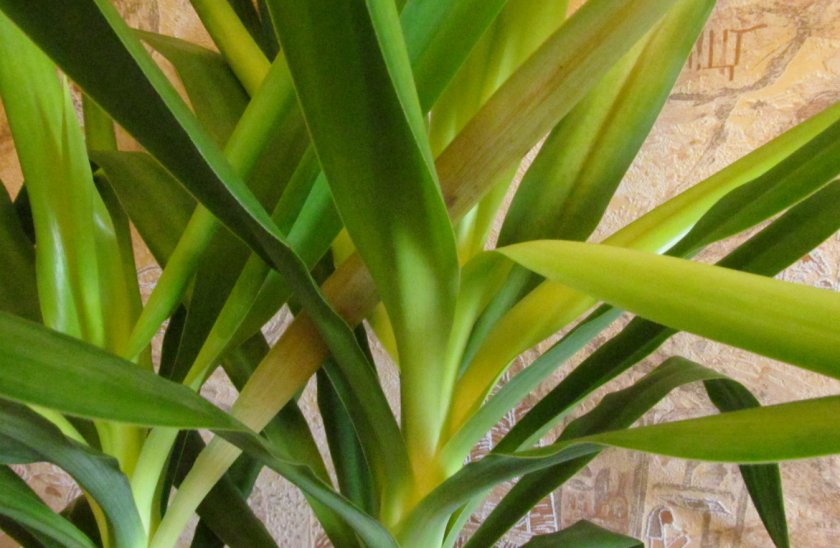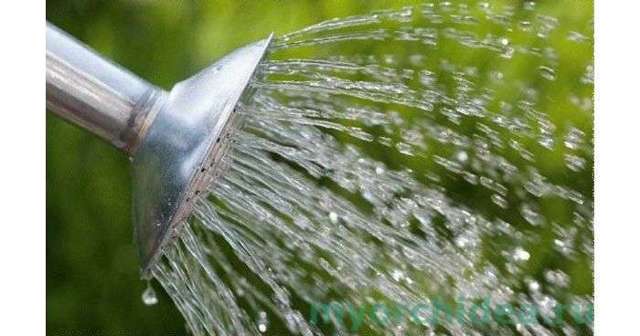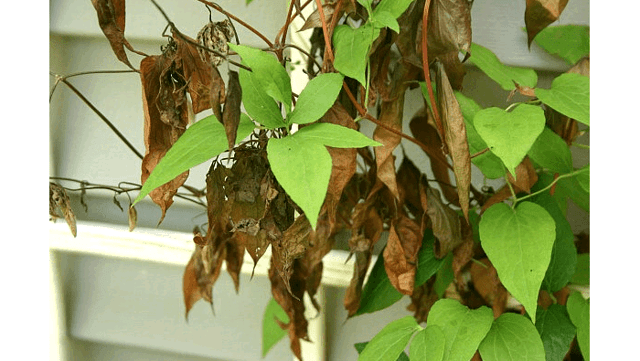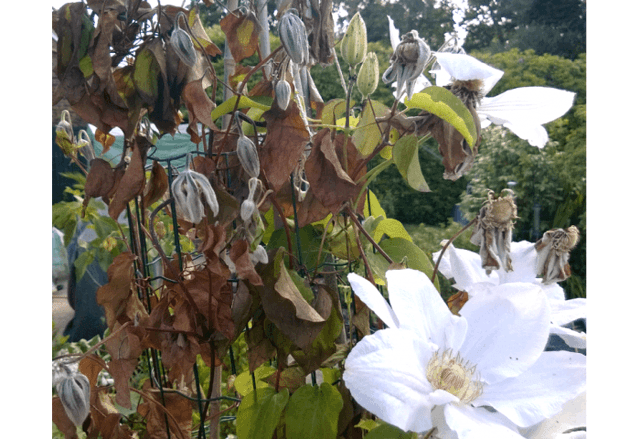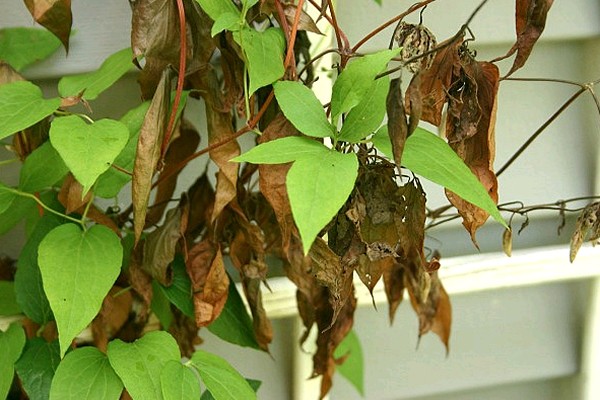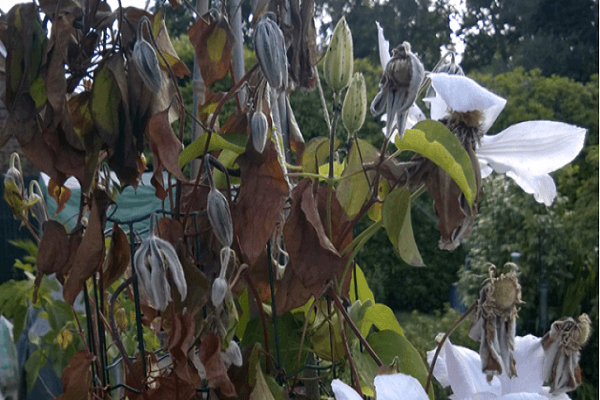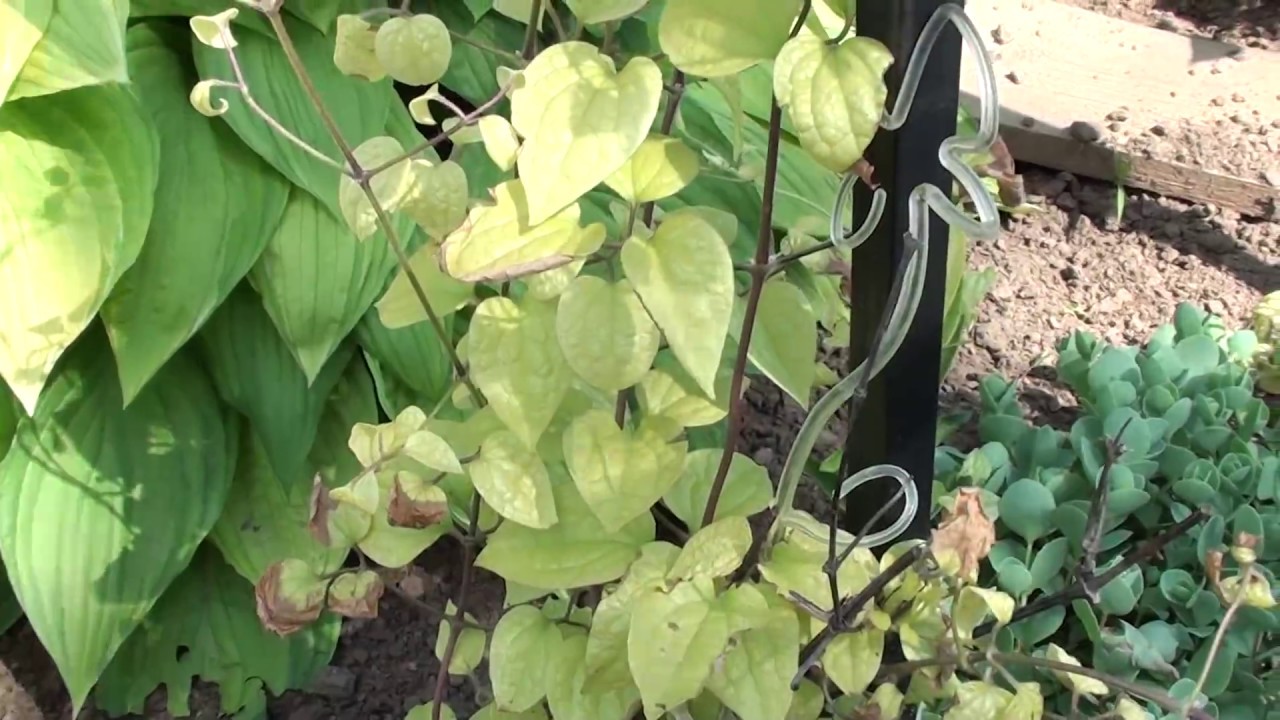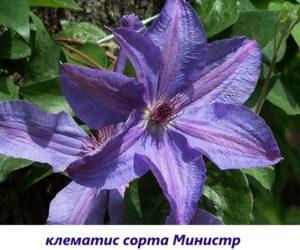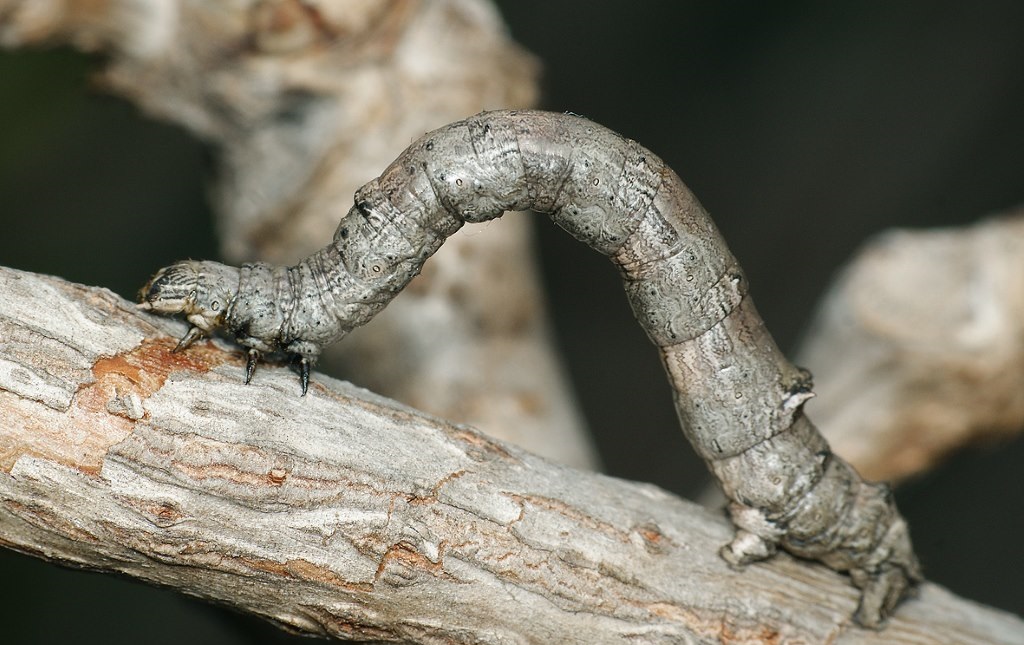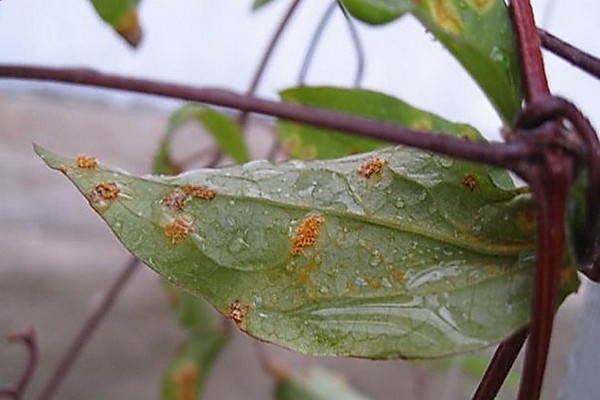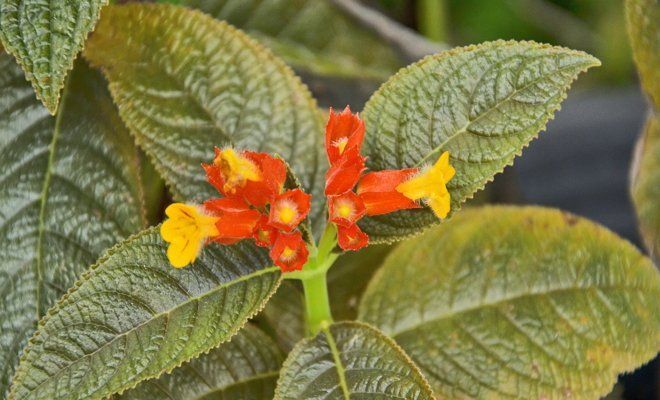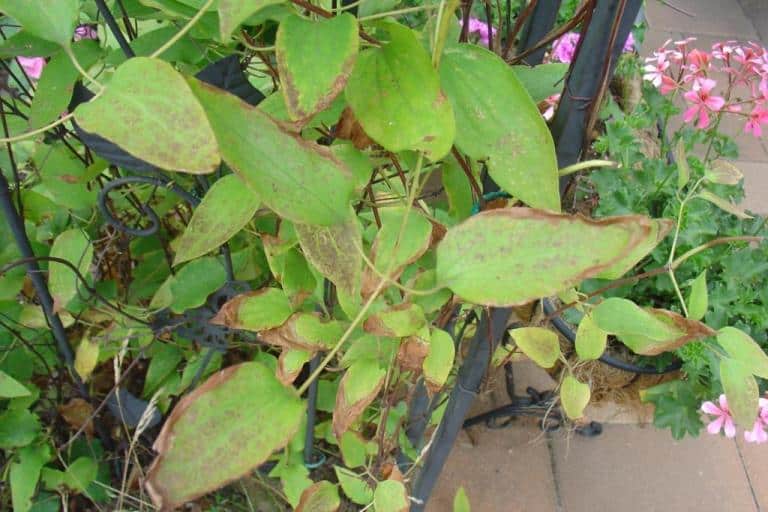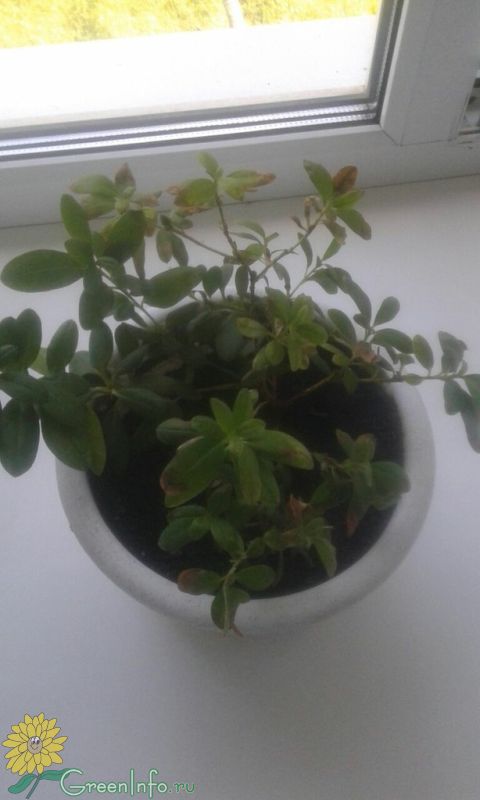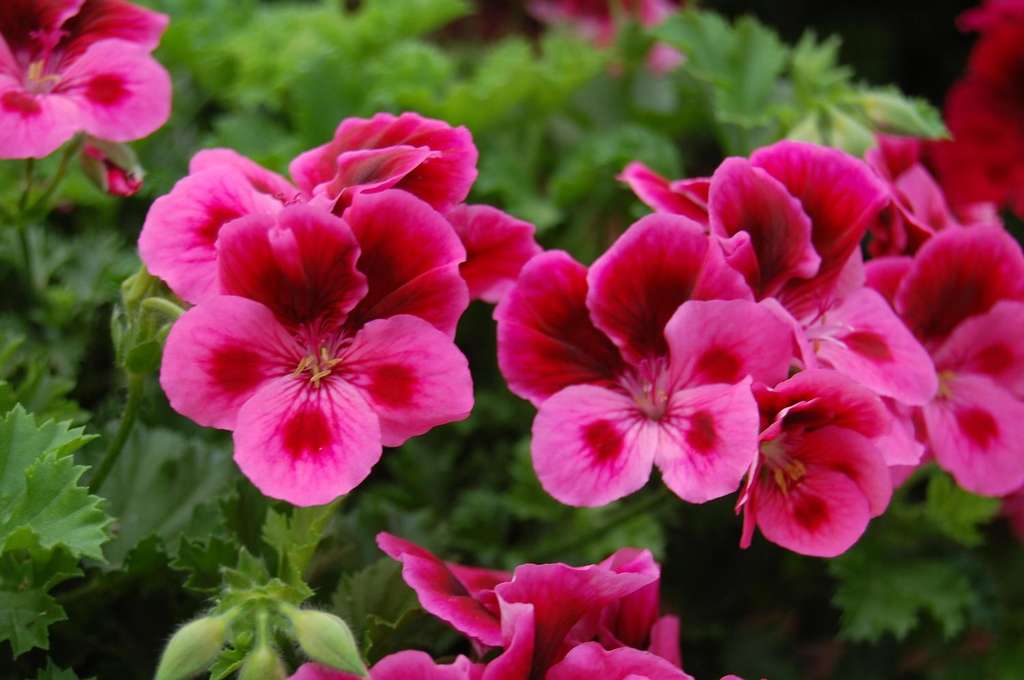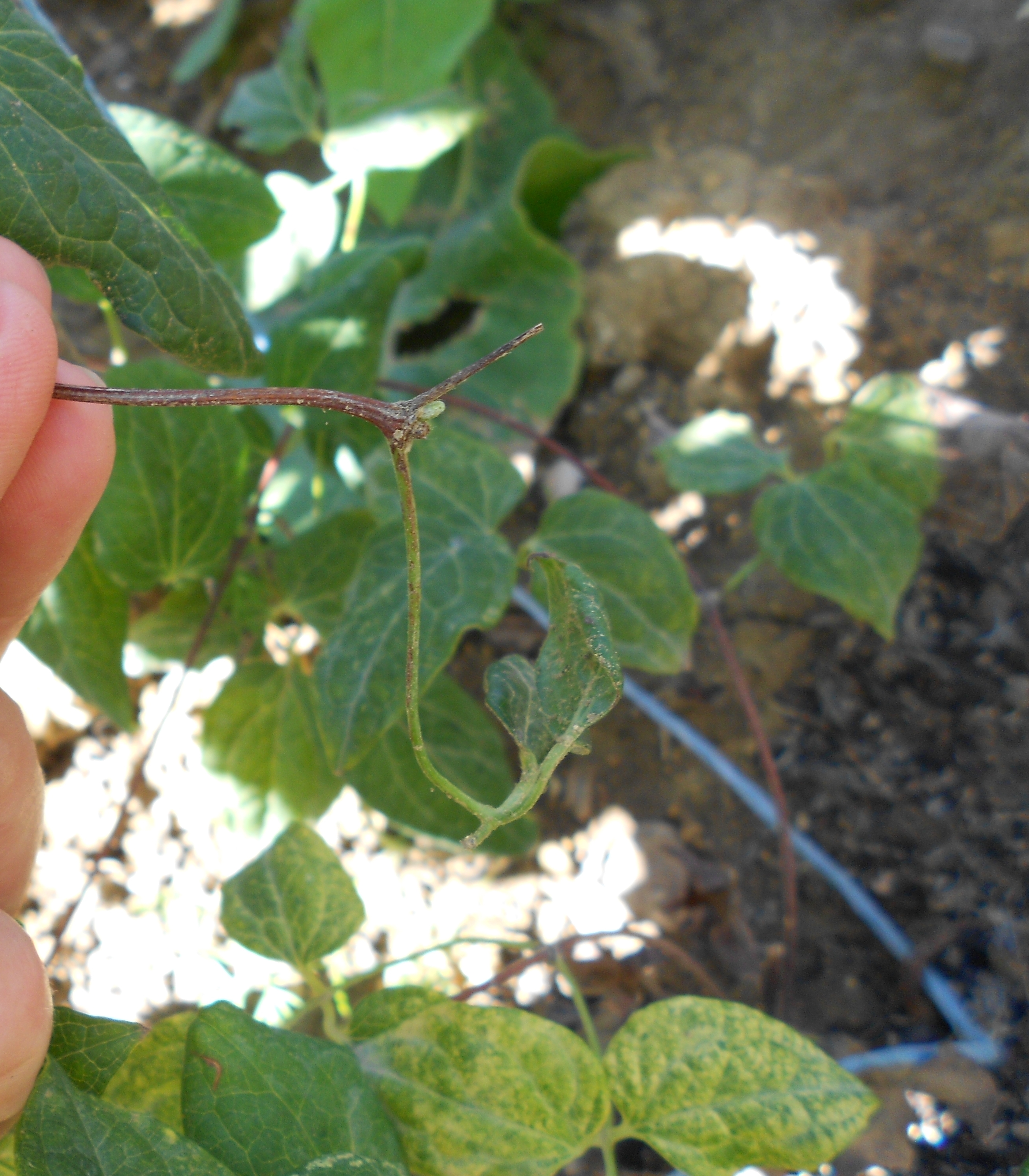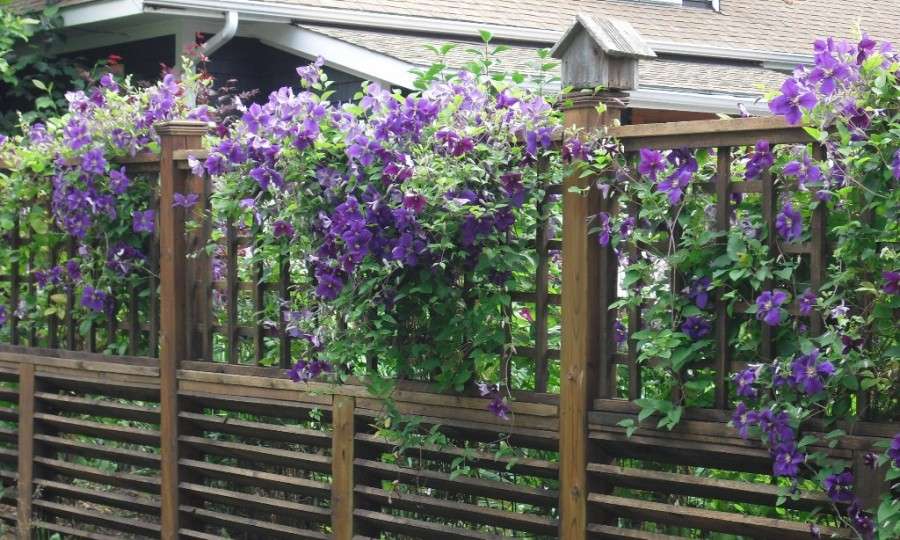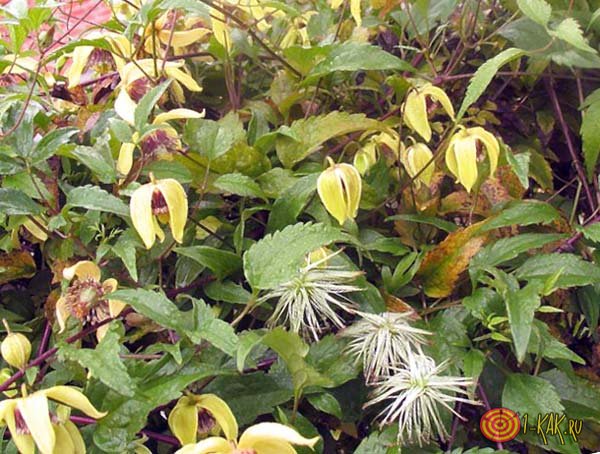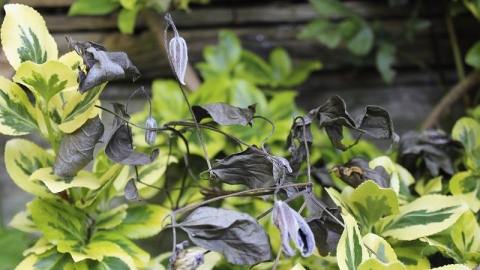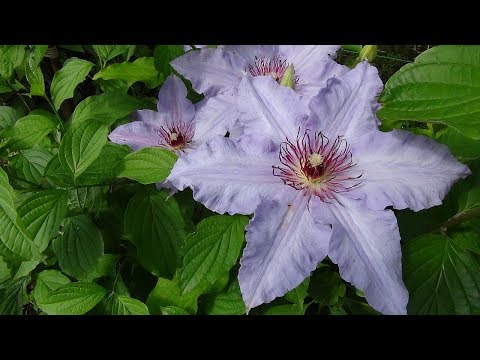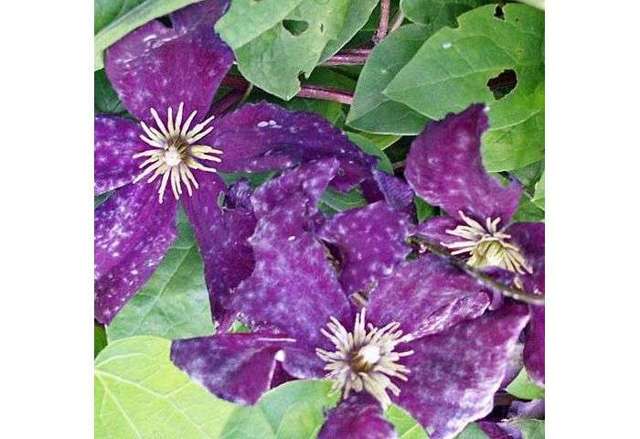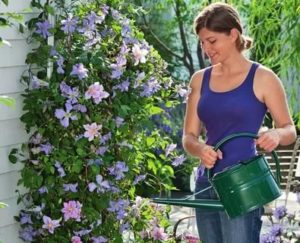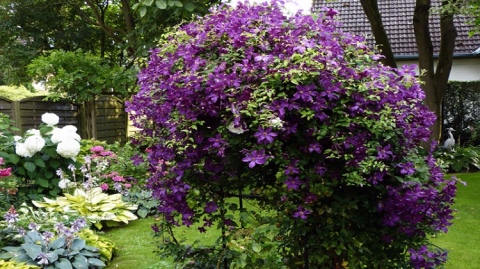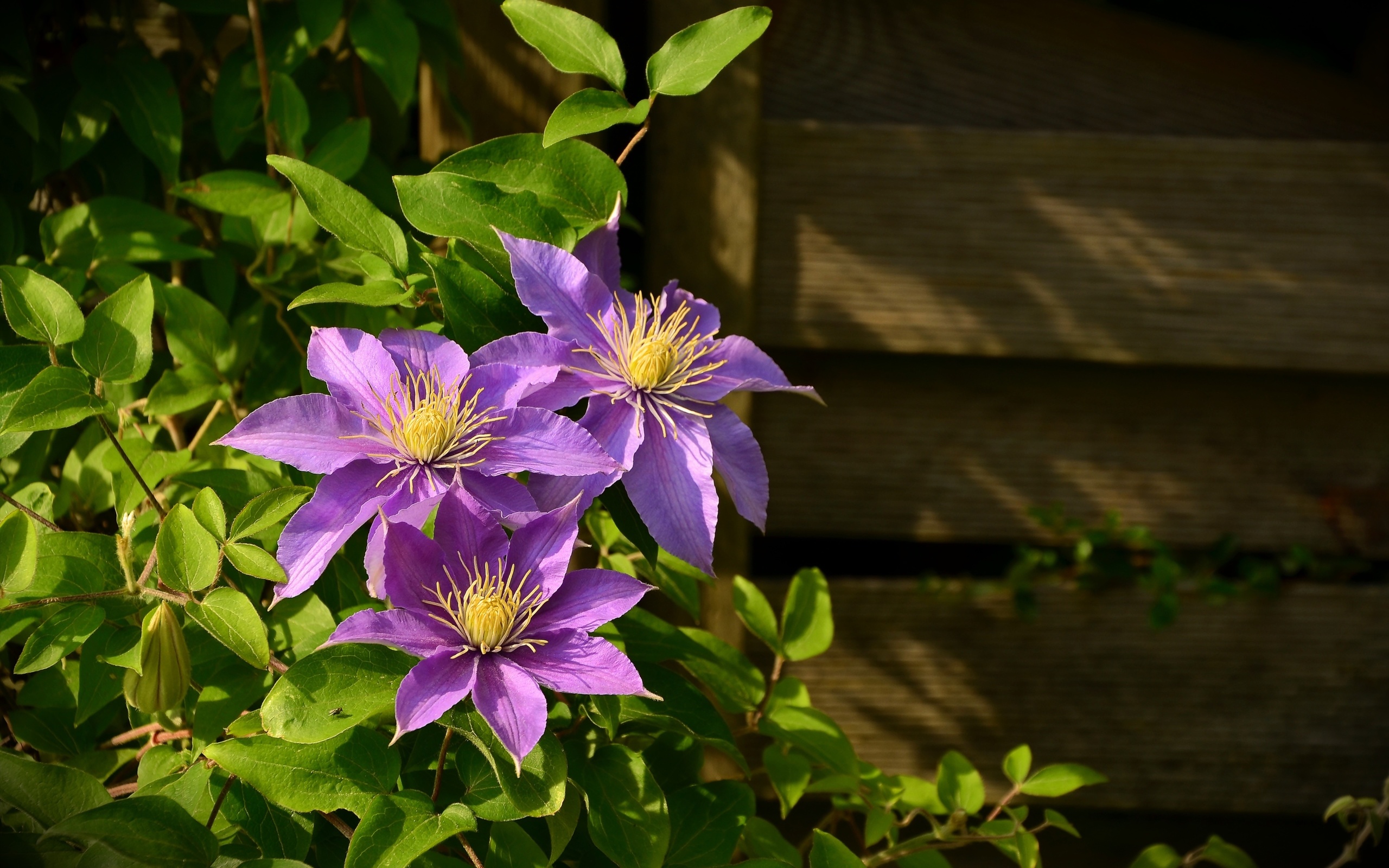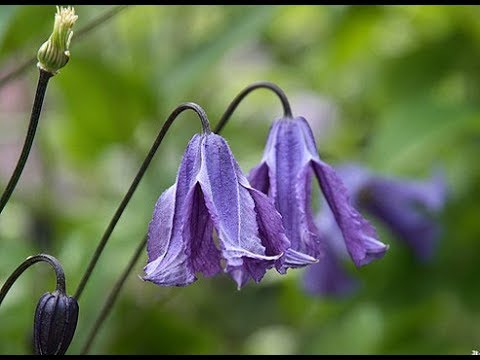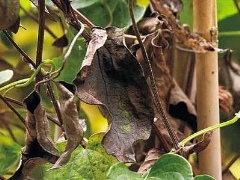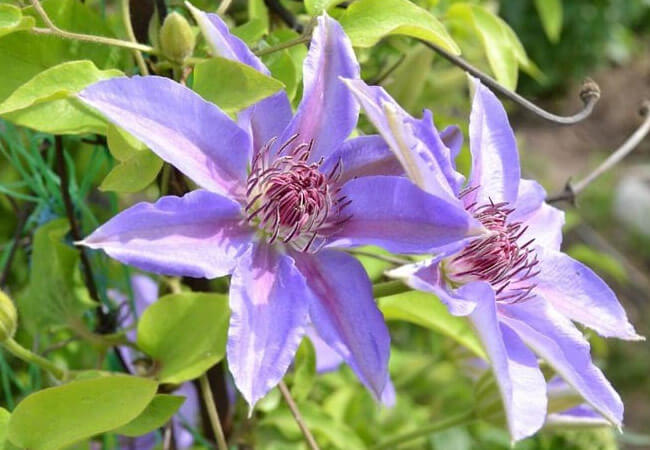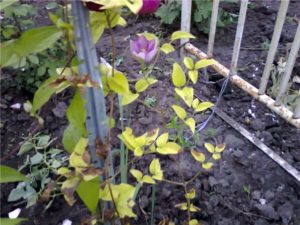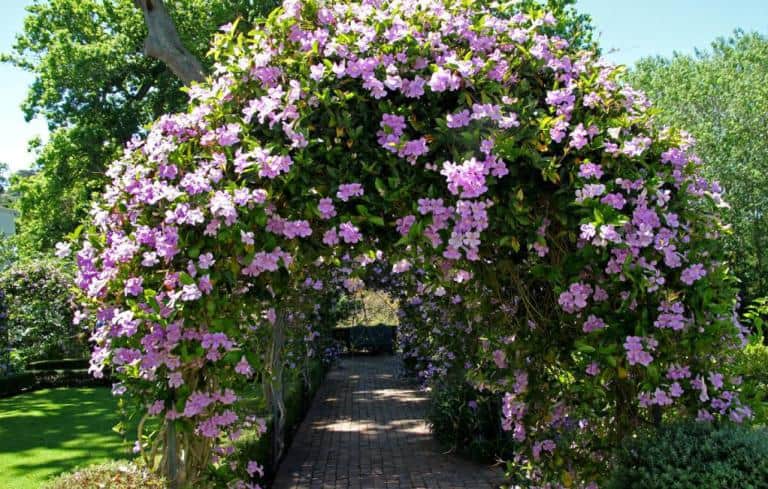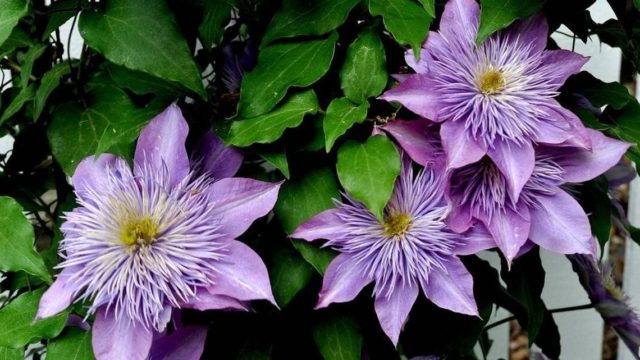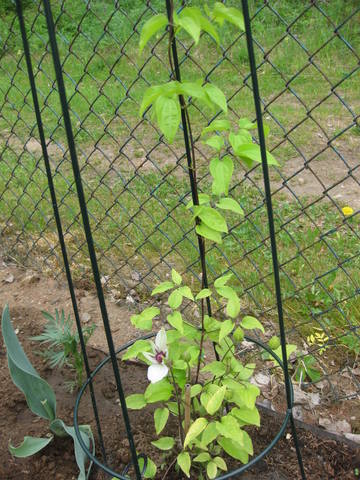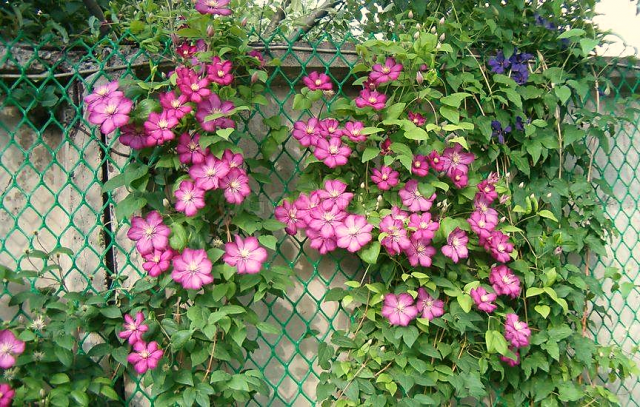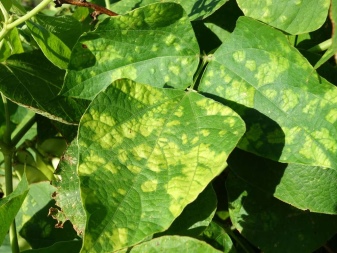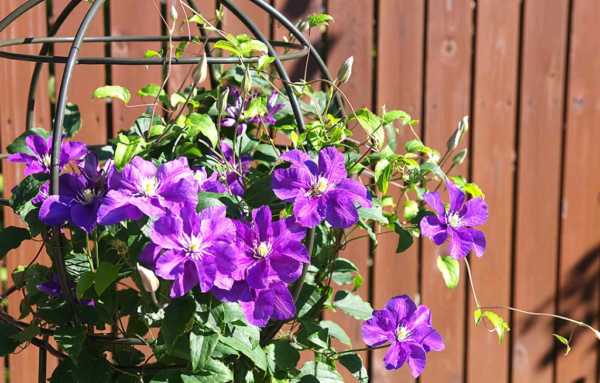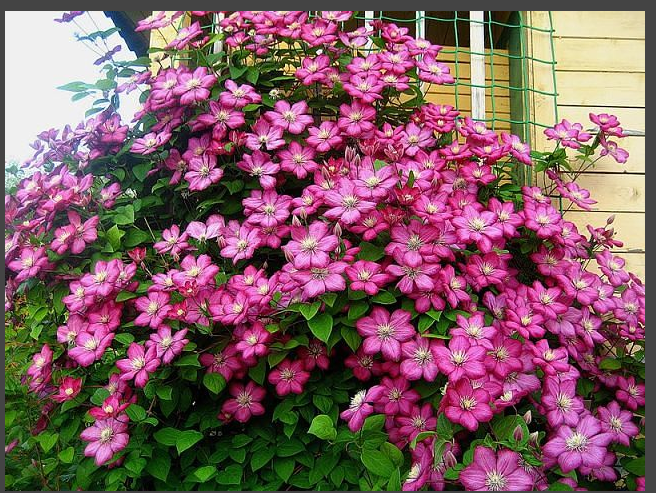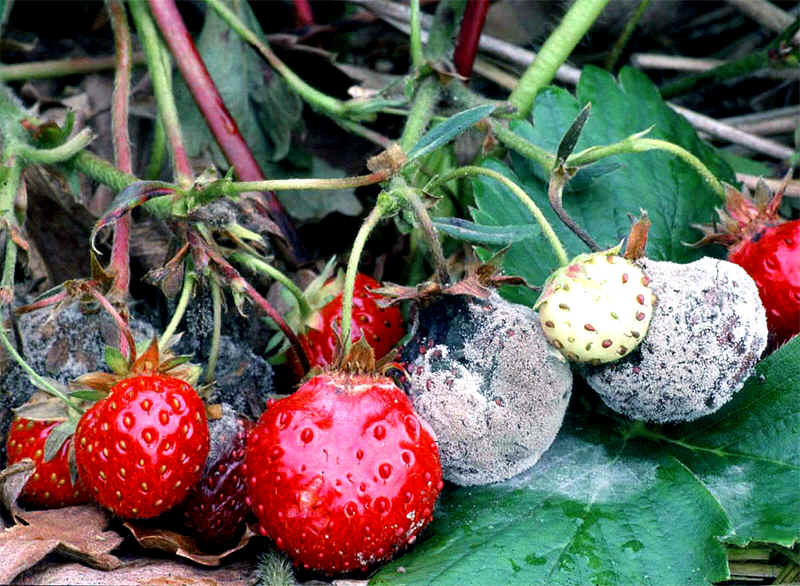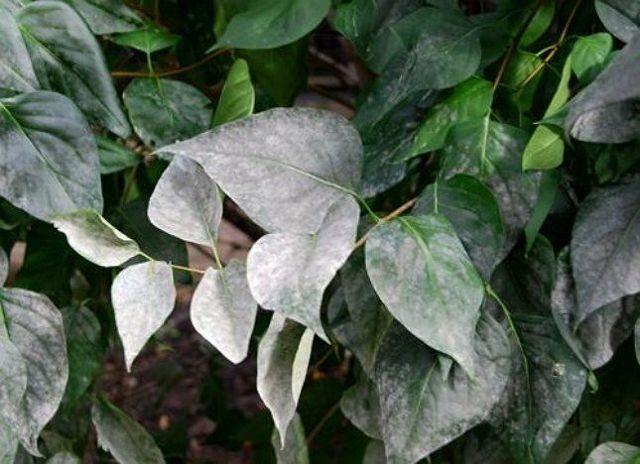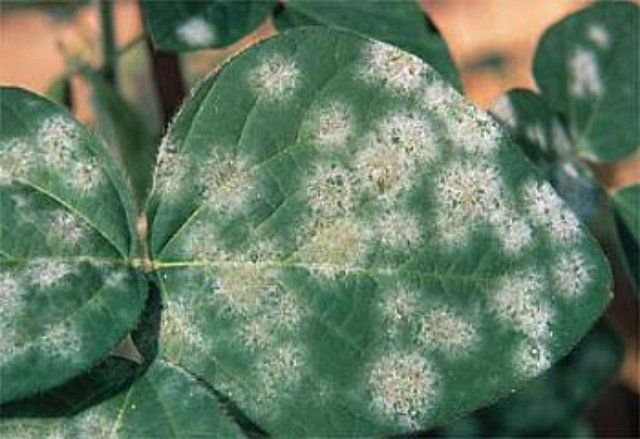Introduction
Clematis are flowering vines and are commonly used for vertical landscaping and decoration of gardens and balconies. With their help, you can revive even the most modest landscape, decorate garden arches, gazebos, pergolas. Clematis is also used for the construction of hedges. The implementation of certain agrotechnical recommendations will allow this plant to reveal its best qualities and, for a long period, please its owners with lush and abundant flowering. Caring for clematis primarily consists of protecting from wind and stagnant moisture in the soil and providing it with reliable support on which its shoots can climb up. Often, it is the strong wind that is the main threat to the health of clematis. If the support for the vine is not strong enough, strong gusts of wind can knock it down and damage the shoots of the plant. This will lead to a deterioration in the general condition of clematis, which becomes an easy target for fungal infections. First of all, the leaves of clematis are affected. Such dangerous diseases include verticillosis, also called wilt, which causes wilting and death of the vine.
One of the ways to reduce the risk of spreading fungal infections in the garden is to choose clematis varieties wisely. To date, through the efforts of breeders, varieties have been bred that are resistant to infectious diseases. These include such varieties as "Prince Charles" ("Prince Charles"), "Violet star" ("Etoile Violette"), "Betty Corning".
There are also varieties resistant to fungal diseases with large flowers: "Niobe", "Gypsy Queen", "Pink Champagne" and others.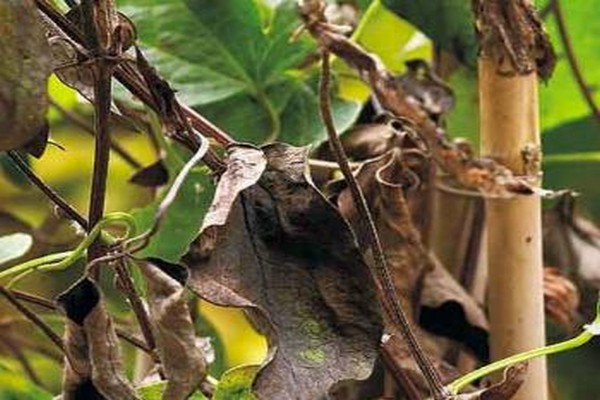
Prevention of diseases and pests of clematis
During the period of active growth of clematis, it is most susceptible to wilting. Fungal spores living in the ground cause damage to the root system of the plant. Sluggish and drying out shoots are the first sign of the disease.
Improper or poor-quality soil drainage, stagnation of moisture in the soil during excessive watering, improperly organized snow retention leads to the spread of the disease on the site.
The diseased plant must be watered with a solution of foundationol (1 gram of the drug per 1 liter of water), and all damaged shoots are removed. In early spring, you can spray the plant with a 3% solution of copper sulfate.
Diseases are far from the only reasons for the death of clematis. Numerous pests can also cause plant damage. As a rule, these are insects that damage the roots and leaves.
As a result of damage by pests, the bushes weaken and die. That is why you need to carefully monitor the plants and take timely measures to eliminate harmful insects.
Causes

If you grow varieties that are not adapted to your climate, an adult plant will be more susceptible to pests, as the immunity of such a crop is weak.
Symptoms
Aphids settle in colonies on the underside of aphid leaf and feed on plant juices. As a result, the leaves lose their original appearance, dry out and curl.
The spider mite provokes the formation of white dots on the underside of the leaf, and the plant itself is covered with cobwebs. This pest sucks the juices from the plant and the clematis itself weakens.
Slugs crawl out of their hiding places in the dark and eat leaves and stems. As a rule, they cause single damage, but in case of a mass invasion, it is imperative to take measures and destroy the pests.
Treatment
For aphids, it is recommended to use the drug Fitoferm. 2 mg of the drug must be diluted in a liter of water and used to spray the bushes. The action of the remedy lasts for 10-20 days.
 Figure 4. The main pests of culture: 1 - aphids, 2 - spider mites, 3 - slugs
Figure 4. The main pests of culture: 1 - aphids, 2 - spider mites, 3 - slugs
You can also use an aqueous infusion of celandine, which is used for spraying. Acaricides and insectoacaricides are effective against spider mites. These are very toxic preparations that are diluted in a ratio of 1 mg per liter of water and use two liters of the ready-made solution to spray 10 square meters of plantings.
Of the folk methods against this pest, a dishwashing detergent diluted to the consistency of a soap solution is used.
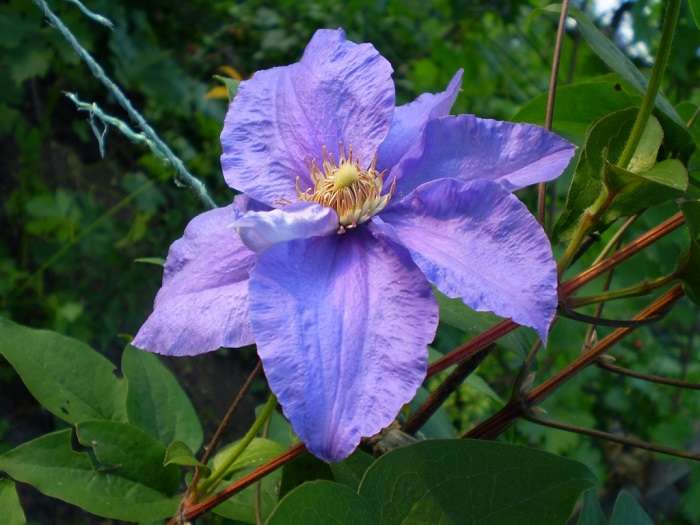
Spraying a plant with ammonia is detrimental to slugs (2 tablespoons of ammonia per 1 liter of water). You can also scatter Ferramol over the site or lay out baits and collect slugs by hand.
To make clematis more resistant to diseases and pests, you need to properly care for them. For example, feeding is carried out no more than twice a month. After the sprouting of the shoots, foliar fertilizing is applied, and during the budding and flowering period, mineral fertilizers are applied.
For the prevention of diseases, you can use a solution of copper sulfate, which is used for root watering. However, in the spring, such watering is carried out no more than once a week. After the procedure, the soil is mulched to prevent evaporation of moisture from the soil.
Planting clematis on the site without fail implies further prevention of diseases. To do this, you can treat the soil with a 0.1% Fundazol solution immediately before planting. In the future, the treatment can be repeated at intervals of two to three weeks.
How to protect clematis from disease
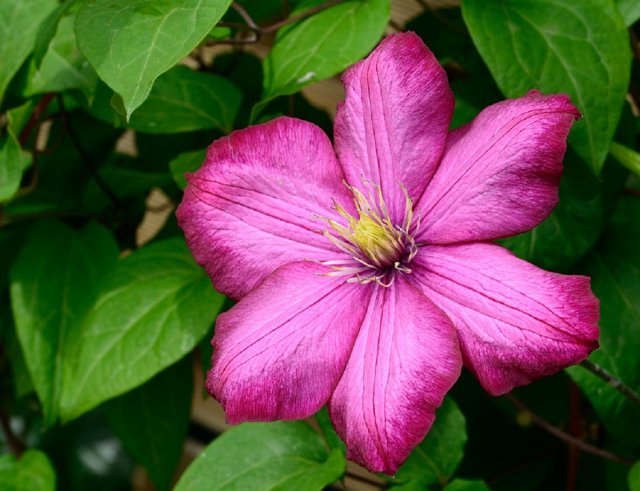
To prevent your clematis from becoming a victim of fungal infections, it is enough to follow a few simple rules:
- choose a suitable place for the plant to grow - it should be dry and protected from gusty winds, at least for several hours a day it should be illuminated by the sun;
- use a shading net to protect clematis from the bright sun;
- in order to ensure high-quality ventilation, fix the support along which clematis will rise at a distance of 8-10 cm from the wall of the house;
- the soil for clematis must pass air and moisture well, humus or compost must be added to it;
- in order to protect plants from weeds, the soil under the bushes can be mulched with crushed bark or other similar materials;
- watering clematis can only be at the root;
- young plants need to be fertilized and watered regularly (especially in the first two years of growth).
The soil around the clematis bushes cannot be loosened with a rake - you can damage the root system and shoots, thereby allowing pathogenic fungi to penetrate the plant.
In order for clematis to decorate your garden, you need to provide it with comfortable conditions. In gratitude for this, he will delight you with wonderful flowers. And our tips will help protect the plant from wilting.
Among the diseases of clematis, the following fungal diseases are distinguished:
1. Withering
- the most dangerous fungal disease associated with the fact that clematis have a root system that can go into the soil by 1 m.
In an outwardly healthy flower, shoots suddenly become lethargic, which then dry out.
The disease is caused by spores of a fungus that lives deep in the soil. It clogs the blood vessels, which is why the metabolism is disturbed and the shoot withers.
Most often, wilting is observed in early spring after a warm winter, as well as from stagnant water, shading of the plant. The disease often occurs during a period of intensive growth, since plant tissues work most rapidly, and the plant wilts within a few hours.
When a disease appears, it is necessary to remove all affected shoots and water the plant with a solution of foundationol.A good result is also obtained by spraying with a solution of copper sulfate in early spring. To avoid wilting, you need to feed clematis, remove weeds.
2. Gray rot
can be recognized by brown spots on shoots and leaves. Spores spread quickly and clematis can infect other nearby plants.
Gray rot is observed in rainy years. For treatment and prevention, you need to spray and water the bush with a solution of foundationol.
3. Leaf spot (ascochitis)
is expressed in the appearance of brown spots with a well-defined edge on the leaves: they become brittle and the spots can crumble, forming holes.
Spotting leads to disruption of photosynthesis and weakening of clematis, which reduces its flowering. The affected leaves must be removed and the plant must be sprayed with a solution of copper sulfate.
 4. Powdery mildew
4. Powdery mildew
affects shoots, leaves, flowers.
Clematis becomes covered with a white coating, under which the tissue dies off.
The growth and flowering of the plant stops. Powdery mildew occurs most frequently during the hot summer months, mainly in the southern regions.
For prophylaxis in the spring, damaged shoots are cut off and sprayed with a solution consisting of 30 grams of copper sulfate and 300 grams of soap diluted in 10 liters of water. Spraying with a solution of soda ash is also effective.
5. Rust
manifests itself in the appearance on the leaves and shoots of clematis of red pads, in which there are spores of the fungus. This leads to wilting of the leaves.
At the first signs of the disease, you need to cut out the damaged leaves and shoots and sprinkle the plant with 2% Bordeaux liquid.
 6. - dying off of weakened leaves, observed in August-September.
6. - dying off of weakened leaves, observed in August-September.
It is caused by a fungus that settles on old parts of the plant and causes necrosis. But with a strong defeat, it can go on to healthy leaves and shoots.
All copper-containing preparations are effective for the fight.
7. Septoriasis
can be identified by gray spots with a reddish edge. Due to damage to the leaves, photosynthesis is disrupted, the plant becomes weak. For treatment, spray with a 1% solution of copper sulfate or Bordeaux liquid.
Viral diseases
Rarely, but clematis also get sick with viral diseases:
1. Yellow mosaic of leaves
caused by viruses carried by sucking insects. There are no effective treatments, so it is better to remove damaged plants.
For prevention, you do not need to plant delphinium, hostu, peony, bulbous plants next to it. After trimming the plants in the garden, you need to treat the tools with a disinfectant solution.
Colorless flowers appear due to improper fertilization, insufficient lighting and heat. When the causes are eliminated, the plant recovers.
Preventive measures
As you know, disease is easier to prevent than to cure. And in the case of clematis disease, this rule works 100%. Competent spring care helps to increase the resistance of clematis and effectively prevents the infection of the bushes by overwintered insects.
Agricultural rules are standard here.
The entire winter layer of mulch must be removed. It most often contains eggs of insects, parasites, and fungal spores.
Any spring dressing must be accompanied by foliar spraying. For this, the fertilizer is diluted in a double volume of water.
A universal method that protects clematis from damage by insects and diseases is the treatment with Bordeaux liquid. It is produced in the spring: the soil is irrigated every 2 weeks, and the green parts are sprayed until the beginning of bud formation.
Application of nitrogen-based fertilizers to the soil in early spring can enrich the soil and stimulate the growth of clematis
Such dressings need to be done 2 times a month, timely replacing them with phosphorus and potassium - a healthy and strong plant gains the ability to resist infections.
It is very important to regularly inspect the green parts and flowers of clematis for the appearance of pests and the first signs of fungal infection.


However, pest prevention does not end with spring treatment. Throughout the growing season, the soil must be maintained in a loose state, by all means remove weeds and mulch the soil. The plant needs a sufficient level of moisture - the roots of clematis lie 1 m in the ground, so watering should be quite abundant. So, an adult bush needs up to 4 buckets of water at a time. At the same time, stagnation of moisture in the ground should not be allowed - in rainy and cloudy weather, it is necessary to immediately prevent fungal infections.
In conclusion, we will dwell on the problems of clematis, which are of a physiological nature - that is, their causes are in no way related to the activity of garden pests and pathogenic microflora. Many diseases are associated with mistakes in care - improper moisture regime, lack of certain minerals, poor control of soil composition. Thus, partial clarification of leaves and flowers is most often the result of insufficient lighting, prolonged temperature drop or nitrogen deficiency in the soil.
Reddening of the stems is usually observed during hot and dry periods. If the flowers and the edges of the leaves have changed their shade to brown, while the buds have dried up without blooming, this directly indicates a lack of potassium. But the shortened internodes, a decrease in the growth rate of shoots, on the contrary, indicate its excess.
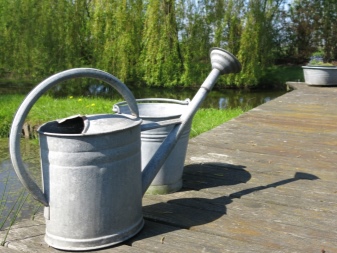
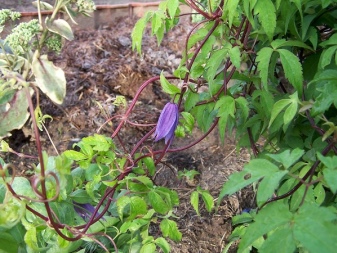
With a lack of magnesium, the roots become fibrous, and with a deficiency, the young leaves turn yellow. Chlorosis of the leaves starting from the top, accompanied by an abnormally whitish color of the flowers, indicates that the plant requires iron. If there is too much iron in the soil, the bush stops growing, and the internodes are shortened.
In the next video, you will find an overview of clematis diseases and pests.
How to feed clematis
Clematis requires a lot of nutrients, due to the fact that it blooms for a long time, and also renews almost completely the entire aerial part of the plants every year.
But it is important to remember that the concentration of mineral fertilizers should not be high - apply them in small portions
Some experienced gardeners say: if you fertilized the soil well, then clematis should be fed only in the third year after planting.
Mineral and organic fertilizers must be alternated. Before fertilizing, clematis must be watered well.
Clematis is fed depending on the phase of plant development, but no more than 4 times per season.
In September, during preparation, add bone meal (200 g / m2) to the soil. The fact is that it contains phosphorus, which is very necessary for clematis.
Without it, the leaves will begin to turn brown, the roots and shoots will develop poorly.
You can also add up to 24 kg of humus under each clematis bush just before planting.
The plant needs nitrogen during its growth. Due to a lack of nitrogen, clematis shoots may shrink, the leaves turn yellow, acquire a reddish tint, the flowers will be small, with poor color. For this type of feeding, organic fertilizers are used: slurry (1:10), bird droppings (1:15).
Organic fertilizers should be alternated with mineral fertilizers: ammonium nitrate, nitroammophoska or urea (15 g / 10 l).
Potassium will contribute to your plant's beautiful flowering. Blackened peduncles and pedicels, lightened color of flowers indicate a lack of potassium. Use potassium nitrate in spring, potassium sulfate in August. Dilute 20 - 30 g in 10 liters.
During the flowering period, feeding is stopped. By feeding the plant during this period, you run the risk of shortening the flowering period.
Preventive actions
It is known that it is easier to prevent any problem than to deal with it. This axiom fully applies to the protection of clematis from diseases and pests.No experienced gardener will neglect the protective measures that create favorable conditions for maintaining the health of clematis.
The site owner must adhere to the following rules:
- keep the garden and surrounding area clean. It is necessary to regularly mow the lawns, remove weeds from the beds, flower beds, paths, as well as from the strip of land located directly behind the fence. All unnecessary green mass should be destroyed so that pests do not start in it, fungal spores do not spread and pathogens do not multiply;
- deep loosening of the soil twice a year (in spring and autumn);
- control the composition of the soil and maintain in it the optimal ratio of substances necessary for the life of plants;
- plant next to clematis cultures, the neighborhood with which has a beneficial effect on the well-being of vines (coriander, dill, mint, marigolds, calendula, etc.);
- do not allow joint cultivation of plants that have diseases in common with clematis (for example, peonies, phlox, delphiniums or hosts);
- when planting newly purchased seedlings, carefully check them for pests or signs of infection. If necessary, disinfect the root system;
- attract insects and animals (ladybirds, bumblebees, wasps, spiders, toads, lizards, hedgehogs and birds) to the garden, which are natural enemies of clematis pests.
Protecting your favorite clematis from diseases and harmful insects is not so difficult. You just need to be attentive to the state of green pets and respond in time to emerging problems.
Why does clematis grow poorly?
Clematis can lose in splendor and growth rate due to a number of factors:
Initially incorrect planting of the plant
It is very important that clematis has a "living space" of about half a meter in radius, especially in the early years. It is necessary to constantly pull out weeds and other plants that can interfere with the prosperity of clematis
The circle of pure earth retains the heat of the sun and transfers it to the roots of the plant.
Lack of light or moisture. The constantly shaded area of the garden is not the best place for a guest from the subtropics to land.
Plant age. Clematis begins to bloom luxuriously only a few (more often 3) years after planting in the garden.
Insufficient power of the root system. You can fight this flaw by using the simplest manipulation. The bush is dug up, and the roots are carefully cleaned from the soil. Then you need to trim the roots by about half a centimeter. If everything is done correctly, the result will not be long in coming next year.
Deficiency of minerals. This is the most common cause of rod problems.
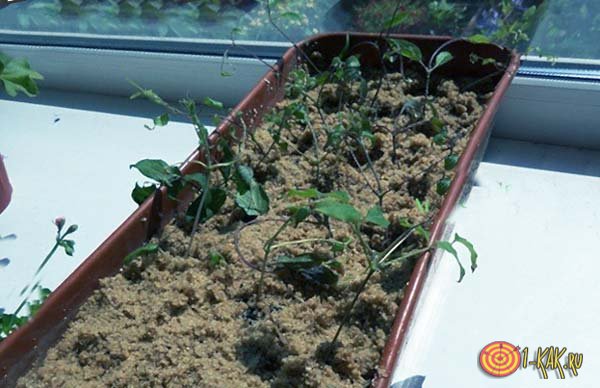
Methods for treating clematis from nematodes
Loading …
For clematis, the most dangerous are three groups of fungi: Verticillium, Fusarium and Phomopsis.
The most common infections:
- Wilt is a fungal disease that, with its rapid development, destroys a vine in just a few days. If the disease progresses slowly, then the variety can be saved. It is manifested by the loss of turgor of the shoots, their wilting, blackening. Unfortunately, the plant can only be helped at the initial stage of infection. In addition, there is no 100% guarantee to cure the bush. For the purpose of prevention, it is used: 0.1% solution of foundationol (the soil is watered before planting the seedling), every year the soil under the plant is spilled with a systemic fungicide, during the growing season, trichodermin is introduced (2 g of the drug per 1 sq. M. Is applied 2 times with an interval of 2 weeks).
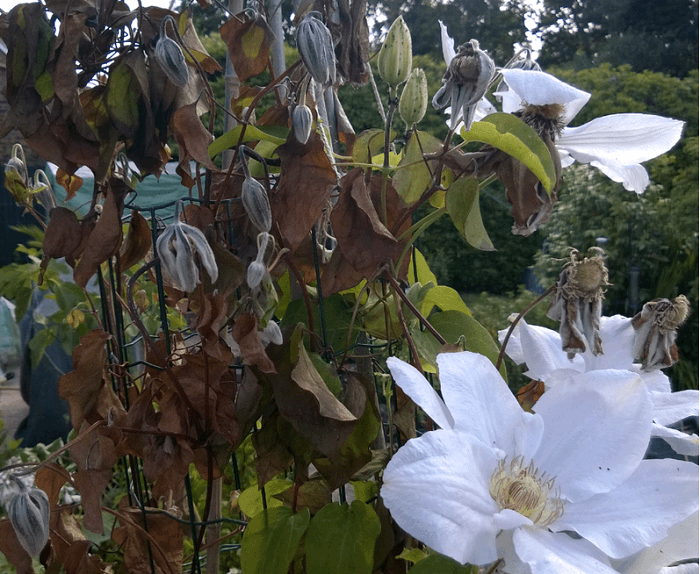
Fusarium appears in the middle of summer. Symptoms: blackening and drying of weak shoots at first. If there is no treatment, the bush dies.

Nematodes are a disease that affects the root system. To combat the problem, it is necessary to treat the root with a special preparation and transplant the plant to a new place.
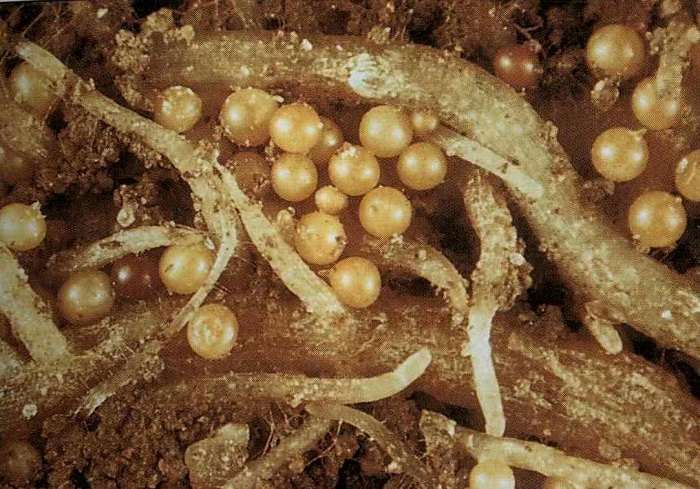
Professionals recommend spraying neighboring plants in the garden as well, since fungal spores spread over many meters.
Nematodes most often affect the leaves and tissues of the kidneys. As a result, the bushes turn brown and dry, and without treatment, all plants can die. The spread of the nematode is facilitated by a large number of weeds, infected seeds and water.
To eliminate nematodes or prevent their spread, the following methods are used:
- Use only healthy seeds and cuttings with mandatory pre-sowing treatment with hot water;
- The bushes need to be carefully looked after: water, feed and remove weeds on time;
- All affected parts of the plant and bushes are not treated, but disposed of.
In addition, it is not recommended to use plant residues that have been infected with nematodes as compost. The larvae of the pest remain in the ground and are activated under favorable conditions.
The main types of diseases of clematis
Clematis has one feature - a well-developed root system that goes deep into the ground.
Most often, because of this, these plants can die from various diseases. In this section, we will consider several ailments of this plant, we will figure out why clematis does not bloom, and how to solve this problem.
Did you know?
Clematis is used medicinally as a stress reliever and calming drug.
 Clematis rust is the appearance of orange pads on shoots, petioles and leaves.
Clematis rust is the appearance of orange pads on shoots, petioles and leaves.
The disease manifests itself in the spring. When the disease spreads, the leaves of the plant dry up and the shoots curl and become crooked.
The virus of this disease is a fungus that hibernates on the shoots and infects the growing shoots in the spring. If the leaves and shoots damaged by rust are not removed in time, then clematis will develop poorly and may die. Rust on the leaves weakens the plant and negatively affects its wintering.
For prevention, we advise you to remove the weeds on which the pathogen most often hibernates.
If it was not possible to protect the plant from rust, then at the first signs of it, the damaged leaves and shoots should be removed, and then the clematis should be sprayed with Bordeaux liquid.

Septoria disease (or leaf blight) is a common disease among plants. Clematis also did not bypass this "ailment". The causative agent of this disease is the Septoria fungus.
This disease is characterized by the fact that many small round spots of a dark brown color appear on the upper leaf plates. The size of these spots is 2-5 mm. They are black at the edges. A little later, the affected area brightens, but the black rim remains. If black dots appear on the light spot, you should know that these are the fruit bodies of the Septoria mushroom along with spores. These spores are spread throughout the bush. Affected leaves turn yellow and, dying off, fall off.
The plant remains without leaves, as a result of which physiological processes are disrupted
... The affected plant practically does not bloom, lacks immunity and is susceptible to other fungal diseases.
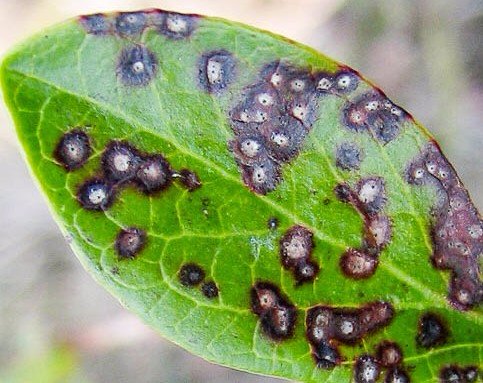
If the fungus spreads, spots appear on the petioles of leaves and on new shoots, the young bark dies off, and the top dries up. The black fruiting bodies of the fungus pass into the wintering stage and survive the winter perfectly on fallen leaves and bark.
Cold and wet weather contributes to the spread of this disease.
In order to avoid infection with a fungus (Septoria), you need to collect and dispose of the fallen leaves, and then process the sections with garden pitch.
If clematis grows in greenhouses, then it is necessary to reduce the humidity of the air and increase the exposure of plants to sunlight.
This disease is caused by phytopathogenic erysiphoid fungi.
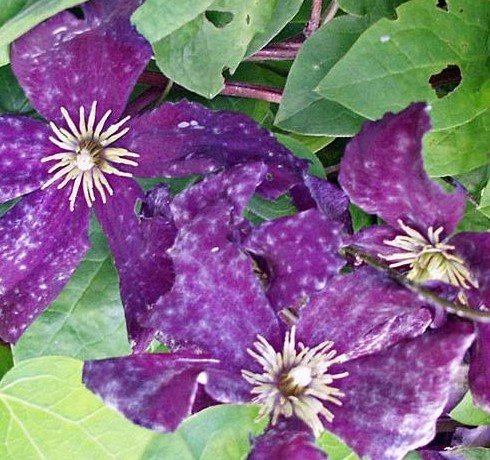
The first symptom of powdery mildew is a white bloom on clematis. Young leaves, buds, flowers and shoots are affected. Plaque can also be found on the stems and leaves of the plant.
After the bloom, the first brown spots appear, the leaves and shoots dry and deform.
Clematis are ill with this disease most often in July and August.
Hot weather promotes the spread of the fungus.
If clematis is sick with powdery mildew, all parts of the bush with a bloom should be cut out and disposed of as soon as possible.
Important!
Infected branches should not be left on the site, otherwise the disease will return.
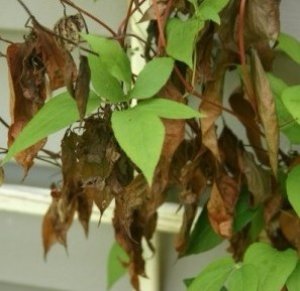 The most dangerous disease of all of these is fusarium.
The most dangerous disease of all of these is fusarium.
Clematis suffer from a fungal wilting called fusarium. This disease penetrates through damaged and weakened tissues. The fungus clogs the conducting "vessels", and the metabolism of nutrients is disrupted. Fusarium wilting is observed in plant species with large flowers. Young plants are also under threat. The fungus grows in shoots damaged at the base. The lesions wither, the leaves turn brown at the edges. This is facilitated by a high temperature of + 20 ... + 30 ° C. The symptoms of this disease appear in the second half of June.
For prevention, you should choose the right landing sites. The fungus develops on flowers that grow in overly moist areas.
Measures to combat this disease:
- cut off all shoots at the base of the bush;
- collect all fallen leaves and dispose of off site;
- disinfect the diseased plant.
Diseases of clematis
Fortunately, viral diseases in clematis are rare, so fungicides are usually used to save plants, which destroy fungi.
Rust
If orange spots appeared on the petioles, leaves and shoots, then clematis got sick with rust. The causative agent of rust is the phytopathogenic fungus Aecidium clematidis DC. If the plant is not treated, its shoots are deformed, the leaves turn brown and curl, dry out and fall off.
Gray rot
In rainy weather, brown spots with a gray bloom in the form of a cannon appear on the leaves and petals - these are spores of the fungus Botrytis. This contributes to the death of leaves and young shoots, as well as stopping the vines in growth. With the help of the wind, the spores of the causative agent of the disease are transferred to healthy plants, and not only clematis. Therefore, if you do not fight the disease, you can lose not only flower, but also garden and horticultural crops.
Powdery mildew
In the middle of summer, clematis can be attacked by powdery mildew: young shoots, leaves, buds and flowers are covered with a white bloom, similar to flour. Over time, the affected plant tissues turn brown and dry out.
Wilt, or wilting
This is the most dangerous ailment that lies in wait for clematis. Wilt is caused by microscopic fungi of the genus Verticillium, which penetrate from the soil into plant tissues through wounds and cracks, after which the mycelium of the fungus clogs the vessels. As a result, the plant cannot "breathe", the shoots darken and wither. Sometimes this happens so quickly that several clematis lashes completely dry out in one day.
Wilt can infect the plant throughout the growing season, but young specimens that do not have enough sunlight are more likely to suffer. Fungicides are used against this ailment, but often they do not cope with this difficult task, so be prepared for the fact that the diseased vine will have to be uprooted.
Causes of drying leaves in clematis
There can be a lot of reasons for the drying of leaves in clematis: only the leaves from above can dry, they can turn black, wither, and then dry up. The main causes of leaf drying are:
- The variety is not correctly selected for the climatic zone;
- The landing site was not selected correctly;
- Watering at lunchtime with strong solar radiation;
- Lack of space, especially if the plant grows in a pot on a window, balcony or in a winter garden;
- Abundant watering;
- Abundant feeding or improper fertilization;
- The root system is not sufficiently covered with soil or its individual parts are open;
- Lean soil;
- Fungal diseases;
- Pests are insects or small rodents.
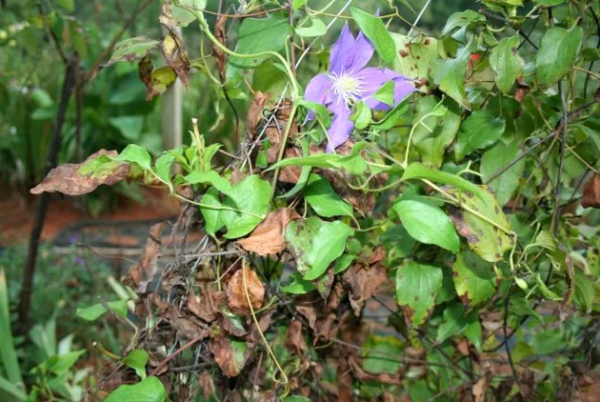
The first 8 reasons are not difficult to eliminate, the main thing is to carefully examine the plant and study the literature on the cultivation of clematis. But the reasons for the drying of leaves in the form of pests and fungal diseases can cause significant harm to the plant or completely kill it.

